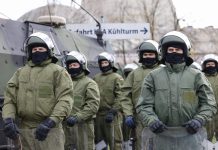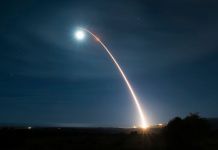Though Russia has expressed its intent to significantly reduce military operations in Ukraine, a ceasefire remains elusive. As fighting continues, Ukraine is gearing up to deploy the deadly Starstreak missiles acquired from the UK.
Latest reports have indicated that the Starstreak air defense systems are now in Ukrainian hands.
“In response to Ukrainian demands, the government has decided to consider the gift of Starstreak high-velocity man-portable anti-air missiles,” UK Defense Secretary Ben Wallace had said in Parliament on March 9 hinting at a swift supply.
He said the Russians are “changing their tactics and so the Ukrainians need to too”, to help Ukraine forces tackle the Russian air force. In response to MPs’ questions about how long the supply decision would take, Wallace said, “We are in principle going to do it,” EurAsian Times had reported.
The United Kingdom has been instrumental in supplying military aid to Ukraine, especially Man-portable air defense systems like Javelins and NLAWs. Its Defense industry has significantly benefited from the war in Ukraine with shares soaring. The British government has bipartisan support for arming Ukraine with laser-guided Starstreak weapons.

Ukraine’s military is believed to have received training in the more challenging Starstreak system via remote online learning and possibly by British instructors based in Eastern Europe. Having said that, the Ukrainian military is poised to introduce the Starstreak MANPADS in combat.
Wallace recently acknowledged that the first Ukrainian troops had been trained on the system, which had now been handed over to them, and that the UK was “doing more than pretty much anyone else” to assist Ukraine in defeating the invasion forces.
Although the Starstreak missile can be launched from land, sea, or air platforms, only land-based versions have been actively deployed on battlefields. On land, the missiles can be launched from the shoulder in the typical MANPADS mode, or they can be combined into portable stand-type Lightweight Multiple Launchers (LML) that can be mounted on light vehicles and contain three ready-to-fire rounds.
While the British Army maintains that only the MANPAD variant was delivered to Ukraine, The Times claimed in one of its reports that both MANPAD and LML variants were delivered. In either case, both have lightweight and portable properties that make them suited for usage in urban settings.
The Ukrainian military has extensively deployed portable anti-tank and air-defense weapons like the Javelins, Stringers, NLAWs, and its own home-grown Stugna-P ATGMs to name a few. In light of this, the usage of Starstreaks would be convenient with the precursor that adequate training has been imparted.
Citing Ukrainian numbers, Wallace stated that Russia had lost 285 tanks, 985 armored vehicles, 44 planes, 48 helicopters, and 109 artillery pieces.
How can Starstreaks be game-changers?
Starstreak is a man-portable air-defense system (MANPADS) developed by Thales in Belfast, where the NLAW has also been produced. According to the manufacturer, the missiles are “designed to provide close air defense against conventional air threats such as fixed-wing fighters and late unmasking helicopter targets”.
Starstreak’s guiding system is the first element of its capability. Most MANPADS fire heat-seeking missiles, which must first lock on to the target’s heat signature before being launched, and then home in on it autonomously in a ‘fire and forget mode.
The Starstreak, on the other hand, uses laser-beam-riding guidance, which means that the missile is launched as soon as a target is recognized in the optically stabilized sight. Throughout the interaction phase, line-of-sight is maintained. The aiming device fires two laser beams at the target and the missile’s sensors calculate the relative locations until impact. The strength of these laser beams is low enough to go undetected by the targeted aircraft, according to the manufacturer.

Another aspect that sets the system apart is that the multiple launchers employ three canister missiles with clip-on equipment and a standard aiming mechanism. Three targets can be assaulted in rapid succession without reloading. This saves precious time and enhances the rapid firing on the target in a shoot-to-kill manner.
It’s extraordinarily fast, reaching a top speed of three times the speed of sound, or Mach 4, which is far quicker than a Stinger anti-aircraft missile’s maximal speed of Mach 2.5. It also has a seven-kilometre range, and each missile carries three very heavy tungsten-alloy darts.
Due to Ukraine’s medium-range SAM threat, Russian jets have been compelled to fly low and fast, making them vulnerable to the shoulder-launched weapon. Starstreak will be especially dangerous for helicopters, as it will give pilots little time to respond, according to National News.
The Starstreak, unlike infrared-guided MANPADS, cannot be fooled by flares or other heat sources. It is effectively impervious to countermeasures, unlike other air defense missiles as the twin-laser approach is more resistant to maneuvering targets.
Another advantage of Starstreaks over other MANPADS in Ukraine is that smaller targets can be engaged, including ones with infrared fingerprints that a heat-seeking missile might not be able to track.
Overall, Starstreak’s capabilities set it apart from the plethora of MANPADS that are being used in Ukraine. The Russian Aerospace Forces as well as its tanks have already suffered a high toll as a result of Ukrainian MANPADS. The addition of Starstreak systems could further embolden the defending troops.
Starstreak would allow Ukraine to defend its skies against low-flying aircraft and assault helicopters without requiring the UK or any other NATO member to send aircraft into the theatre, impose a ‘no-fly zone’ as asked by Ukraine or risk escalation with Russia.
- Contact the author at sakshi.tiwari9555@gmail.com
- Follow EurAsian Times on Google News




